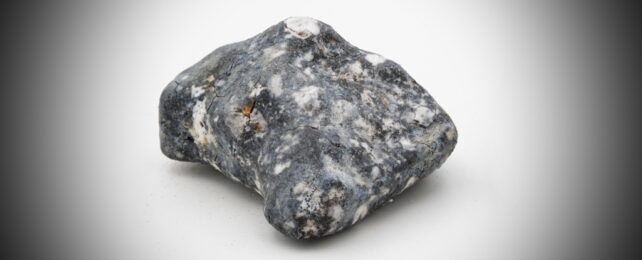ARTICLE AD
 Aubrite meteorite from asteroid 2024 BX1. (Laura Kranich/Museum für Naturkunde Berlin/SETI Institute)
Aubrite meteorite from asteroid 2024 BX1. (Laura Kranich/Museum für Naturkunde Berlin/SETI Institute)
On January 21st, 2024, a meter-sized asteroid (2024 BX1) entered Earth's atmosphere and exploded over Berlin at 12:33 am UTC (07:45 pm EST; 04:33 pm PST).
Before it reached Earth, 2024 BX1 was a Near-Earth Asteroid (NEA) with an orbit that suggests it was part of the Apollo group.
The fragments have since been located by a team of scientists from the Freie Universität Berlin, the Museum für Naturkunde (MfN), the German Aerospace Center (DLR), the Technische Universität Berlin, and the SETI Institute and identified as a rare type of asteroid known as "aubrites".
The name aubrites comes from the village of Aubrés in France, where a similar meteorite fell on September 14th, 1836.
The team responsible for recovering samples of this latest meteorite was led by SETI Institute meteor astronomer Dr. Peter Jenniskens and MfN researcher Dr. Lutz Hecht. They were joined by a team of staff and students from the MfN, the Freie Universität Berlin, the DLR, and the Technische Universität Berlin days after the meteor exploded in the sky.
Together, they found the meteor fragments in the fields just south of the village of Ribbeck, about 50 km (31 mi) west of Berlin.
Finding the fragments was a major challenge because of the peculiar appearance of aubrites, which resemble rocks like any other from a distance but are quite different to look at up close.
Whereas other types of meteors have a thin crust of black glass caused by the extreme heat generated by passing through the atmosphere, aubrites have a mostly translucent glass crust. Christopher Hamann, a researcher from the Museum für Naturkunde, was involved in the initial classification and participated in the search. As he related in a SETI Institute press release:
"Aubrites do not look like what people generally imagine meteorites to look like. Aubrites look more like a gray granite and consist mainly of the magnesium silicates enstatite and forsterite.
It contains hardly any iron and the glassy crust, which is usually a good way to recognize meteorites, looks completely different than that of most other meteorites. Aubrites are therefore difficult to detect in the field."
The asteroid (2024 BX1) was first spotted by Hungarian astronomer Dr. Krisztián Sárneczky using one of the telescopes at the Konkoly Observatory in Budapest.
The task of tracking it and predicting where it would impact Earth's atmosphere was performed by NASA's Scout mission and the ESA's Meerkat Asteroid Guard impact hazard assessment systems, with Davide Farnocchia of JPL/Caltech providing frequent trajectory updates.
Like the Chelyabinsk meteorite that exploded over southern Russia in 2013, the explosion was witnessed by many and filmed (though the explosion caused no damage).
This was Jenniskens' fourth guided recovery of a small asteroid that fell to Earth, the previous events being a 2023 impact in France, a 2018 impact in Botswana, and a 2008 impact in Sudan. As he explained, this latest asteroid was particularly challenging to track down:
"Even with superb directions by meteor astronomers Drs. Pavel Spurný, Jirí Borovicka, and Lukáš Shrbený of the Astronomical Institute of the Czech Academy of Sciences, who calculated how the strong winds blew the meteorites and predicted that these could be rare enstatite-rich meteorites based on the light emitted by the fireball, our search team initially could not easily spot them on the ground.
We only spotted the meteorites after a Polish team of meteorite hunters had identified the first find and could show us what to look for. After that, our first finds were made quickly by Freie Universität students Dominik Dieter and Cara Weihe."
This past week, Jenniskens' colleagues at the MfN officially announced that they had conducted their first analyses of one of the meteor fragments.
The process was led by Dr. Ansgar Greshake, the scientific head of the MfN's meteorite collection, which consisted of an electron beam microprobe studying the mineralogy and chemical composition of the fragments.
Their results revealed they the fragments are consistent with an achondrite meteor of the aubrite type, which were submitted to the International Nomenclature Commission of the Meteoritical Society on February 2nd, 2024, for verification.
"Based on this evidence, we were able to make a rough classification relatively quickly," said Greshake. "This underlines the immense importance of collections for research. So far, there is only material from eleven other observed falls of this type in meteorite collections worldwide."
This article was originally published by Universe Today. Read the original article.

 1 year ago
85
1 year ago
85 

